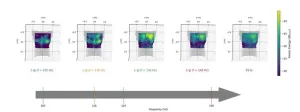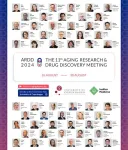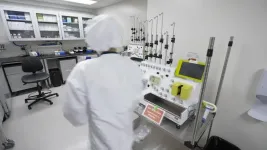(Press-News.org) PITTSBURGH, March 19, 2024 – University of Pittsburgh School of Medicine scientists have identified drug candidates that show promise to reverse the ability of HIV to escape detection by the immune system.
The discovery, described today in Cell Chemical Biology, reveals a potential path to eliminate the viral reservoir that cannot be cleared with existing antiretroviral drugs. This reservoir is what prevents people from being completely cured of HIV even when their viral load is undetectable in standard tests.
“We have excellent antiretroviral drugs that suppress HIV, but unfortunately, none of them clear the virus. If someone with HIV stops taking their medication, the infection will rebound,” said senior author Thomas Smithgall, Ph.D., the William S. McEllroy Professor and former chair of the Pitt School of Medicine’s Department of Microbiology and Molecular Genetics. “HIV establishes a reservoir of infected cells that lay dormant even in the presence of antiretroviral therapy, hiding from immune system detection. We think we’ve uncovered a key to unmasking that reservoir.”
The research centers on HIV Nef, a viral protein expressed at high levels after HIV infection. Over the past three decades, Smithgall’s team and others have shown that Nef can prevent the immune system from destroying infected cells by blocking or “hiding” signs of the virus on the cell surface. But unlike other HIV proteins that are expressed during infection, Nef is a challenging target for drug design.
“A protein like Nef is often considered undruggable because it doesn’t have a defined binding site for drug action,” said lead author Lori Emert-Sedlak, Ph.D., research associate professor of microbiology and molecular genetics at Pitt. “Our existing Nef inhibitors, which only bind to Nef, block some Nef functions extremely well, but don’t touch other functions, many of which are critical for HIV infection.”
So the research team took a different approach. Rather than pursuing a drug molecule that might only block one or two Nef functions, they looked for a compound that would mark it for degradation in infected cells. Degrading the Nef protein would block all of its functions, including HIV infection and replication. In addition, HIV antigens would be restored to the surface of infected cells, revealing them to the immune system for destruction.
Working in collaboration with co-author Colin Tice, Ph.D., a senior research chemist at the biotechnology company Fox Chase Therapeutics Discovery, Inc. (FCTDI), the team first identified small molecules that bind to the Nef protein. These Nef binders were then coupled to a second molecule that marks the Nef protein for destruction by a natural cellular process. The resulting drug candidates – called proteolysis targeting chimeras, or PROTACs – triggered Nef degradation, which suppressed HIV replication in target cells and showed signs that the immune response could be restored.
“In general, the PROTAC approach has generated a great deal of excitement at drug companies, but they’ve been almost entirely targeted to proteins involved in cancers,” Smithgall said. “Our Nef-directed PROTACs are one of the first examples targeting infectious diseases. In theory, this approach should be applicable to proteins from other viruses that serve functions similar to HIV Nef.”
The research was funded in part with a small business technology transfer grant from the National Institutes of Health intended to bring academic scientists together with small businesses, in this case FCTDI, which is based in Doylestown, Pa. The highly competitive grants aim to accelerate commercialization of promising discoveries so that they are translated into the clinic faster.
While Smithgall said he is excited for the potential of Nef PROTACs to someday treat HIV infections, he cautioned that several major steps are still required before they can be tested in people. His team will simultaneously pursue preclinical testing in animal models, mapping of the Nef signaling pathways to learn exactly how the PROTACs are working in cells and using advanced crystallography tools to determine the structure of the Nef protein in complex with the PROTAC molecule and the cellular machinery responsible for its degradation.
“Finding a small molecule that bound selectively to Nef, that was the hardest part,” Smithgall said. “Now we have to keep going with medicinal chemistry optimization and see how well it works against the HIV reservoir in an animal model.”
Additional authors on this study are Haibin Shi, Ph.D., John J. Alvarado, Ph.D., and Sherry T. Shu, Ph.D., all members of the Smithgall team at Pitt; and Allen B. Reitz, Ph.D., of FCDTI.
This research was funded by National Institute of Allergy and Infectious Diseases grants R01 AI152677 and R41 AI155054.
END
Drug candidate may ‘unmask’ latent HIV-infected cells, mark them for destruction
2024-03-19
ELSE PRESS RELEASES FROM THIS DATE:
Epidemic of fatal prion disease kuru likely led to migration of women in the Eastern Highlands of Papua New Guinea
2024-03-19
In the most comprehensive genetic study of the people living in the Eastern Highlands of Papua New Guinea to date, researchers from Papua New Guinea and the U.K. revealed the complex population structure and migration patterns of the communities in the region. The results, published March 19 in The American Journal of Human Genetics, lay the foundation for future research on the fatal disease kuru—a disease transmitted during traditional anthropophagic mortuary practices— that devastated the area in the 20th century.
“We navigated one of the most complex landscapes possible in terms of geographical, cultural and linguistic diversity and set the scene ...
Biomarkers of the middle-aged brain predict cognitive health in old age
2024-03-19
The middle-aged brain could provide a window into future cognitive health, researchers write in a review publishing March 19 in the journal Trends in Neurosciences. The team reviewed evidence from human and animal studies suggesting that middle age—commonly considered as the period between 40 and 60 or 65 years of age—marks a shift in brain aging. They argue that more research should be dedicated to middle age, a period of life that is historically understudied.
“Middle age is associated with specific and modifiable risk factors for future dementia risk,” write the authors, who include neuroscientist Yvonne Nolan ...
USPSTF statement on primary care interventions to prevent child maltreatment
2024-03-19
Bottom Line: The U.S. Preventive Services Task Force (USPSTF) concludes that the current evidence is insufficient to assess the balance of benefits and harms of primary care interventions to prevent child maltreatment. Child maltreatment, which includes child abuse and neglect, can have profound effects on health, development, survival, and well-being throughout childhood and adulthood. The prevalence of child maltreatment in the U.S. is uncertain and likely underestimated. In 2021, an estimated 600,000 children were identified by Child Protective Services as experiencing abuse ...
Stroke risk after COVID-19 bivalent vaccination among US older adults
2024-03-19
About The Study: Among 11,000 Medicare beneficiaries age 65 or older who experienced stroke after receiving either brand of the COVID-19 bivalent vaccine, there was no evidence of a significantly elevated risk for stroke during the days immediately after vaccination.
Authors: Yun Lu, Ph.D., of the Food and Drug Administration in Silver Spring, Maryland, is the corresponding author.
To access the embargoed study: Visit our For The Media website at this link https://media.jamanetwork.com/
(doi:10.1001/jama.2024.1059)
Editor’s ...
New ultrasound technology may revolutionize respiratory disease diagnoses
2024-03-19
WASHINGTON, March 19, 2024 – The thorax, the part of the body between the neck and abdomen, provides medical professionals with a valuable window into a patient’s respiratory health. By evaluating sound vibrations produced by the airflow induced within the lungs and bronchial tree during normal breathing as well as those produced by the larynx during vocalizations, doctors can identify potential disease-related abnormalities within the respiratory system.
But, among other shortcomings, common respiratory assessments can be subjective and are only as good as the quality ...
Decision aid helps patients make informed decisions about sterilization
2024-03-19
Researchers at the University of Pittsburgh have developed a simple, web-based decision aid called My Decision/Mi Decisión that helps empower pregnant individuals who are considering tubal sterilization to make informed decisions about their reproductive health, according to a new study published today in JAMA Network Open.
With significant misunderstandings surrounding sterilization, the Pitt researchers can now offer comprehensive, engaging and accessible information to help support individuals as they make the best contraceptive decisions for themselves.
“When patients are making decisions about their health and fertility, we want to make certain ...
New spatial profiling approach maps out discoveries for future brain research
2024-03-19
An estimated one in six people suffer from a brain disorder worldwide, according to the American Brain Foundation. Current research has provided some insight into cell-communication inside the brain, but there are still a lot of unknowns surrounding how this crucial organ functions. What if there was a comprehensive map that took into consideration not just the biology of the brain, but the specific location where the biology occurs?
Researchers in the College of Engineering have developed a powerful, cost-effective method to do just that.
Chang Lu, the Fred W. Bull Professor of Chemical Engineering, has been leading ...
Family out-of-pocket expenditure on dental care
2024-03-19
Alexandria, VA, USA – A study aiming to determine if poorer families pay more for dental care as a proportion of their total income than richer families. was presented at the 102nd General Session of the IADR, which was held in conjunction with the 53rd Annual Meeting of the American Association for Dental, Oral, and Craniofacial Research and the 48th Annual Meeting of the Canadian Association for Dental Research, on March 13-16, 2024, in New Orleans, LA, USA.
The abstract, ...
11th ARDD Meeting Announces initial stellar speaker lineup and XPRIZE Healthspan Team Summit
2024-03-19
According to the United Nations, the proportion of people aged over 65 now outnumber children younger than 5. The enormous growth in the elderly population is posing a socioeconomic challenge to societies worldwide, and necessitates new sweeping interventions for age-associated diseases. This year we have an incredibly exciting program with global thought-leaders sharing their latest insights into aging and how we target the aging process ensuring everyone lives a healthier and longer life. Welcome to the 11th Aging Research and Drug Discovery Meeting.
This year, ARDD is proud to be a partner of XPRIZE ...
Cell therapy approach harnesses the immune system in a different way to stop cancer
2024-03-19
NOTE TO EDITORS: High-resolution b-roll, soundbites and images are available for download at https://bit.ly/3PfnX5Y
COLUMBUS, Ohio – A new cancer treatment that uses a person’s own immune cells has been approved by the U.S. Food and Drug Administration (FDA) for treating the most dangerous type of skin cancer. Now this form of cellular therapy (tumor-infiltrating lymphocyte – or TIL therapy) is showing promise in advanced lung cancers through clinical trials underway at The Ohio State University Comprehensive Cancer ...






